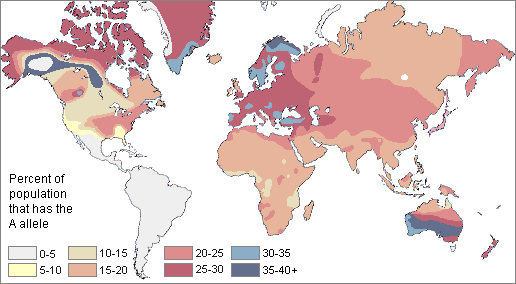Distribution of the B type blood allele in native populations of the world
Distribution of the A type blood allele in native populations of the world
Distribution of the O type blood in native populations of the world
Via anthro.palomar.edu
Distribution of the A type blood allele in native populations of the world
Distribution of the O type blood in native populations of the world
The majority of the people in the world have the Rh+ blood type. However, it is more common in some regions. Native Americans and Australian Aborigines were very likely 99-100% Rh+ before they began interbreeding with people from other parts of the world. This does not imply that Native Americans and Australian Aborigines are historically closely related to each other. Most Subsaharan African populations are around 97-99% Rh+. East Asians are 93-99+% Rh+. Europeans have the lowest frequency of this blood type for any continent. They are 83-85% Rh+. The lowest known frequency is found among the Basques of the Pyrenees Mountains between France and Spain. They are only 65% Rh+.
The distribution patterns for the Diego click this icon to hear the preceding term pronounced blood system are even more striking. Evidently, all Africans, Europeans, East Indians, Australian Aborigines, and Polynesians are Diego negative. The only populations with Diego positive people may be Native Americans (2-46%) and East Asians (3-12%). This nonrandom distribution pattern fits well with the hypothesis of an East Asian origin for Native Americans.
The implication is that the specific causes responsible for the distribution of human blood types have been different than those for other traits that have been commonly employed to categorize people into "races." Since it would be possible to divide up humanity into radically different groupings using blood typing instead of other genetically inherited traits such as skin color, we have more conclusive evidence that the commonly used typological model for understanding human variation is scientifically unsound.
Via anthro.palomar.edu



This post may contain affiliate links. As an Amazon Associate, I earn from qualifying purchases.